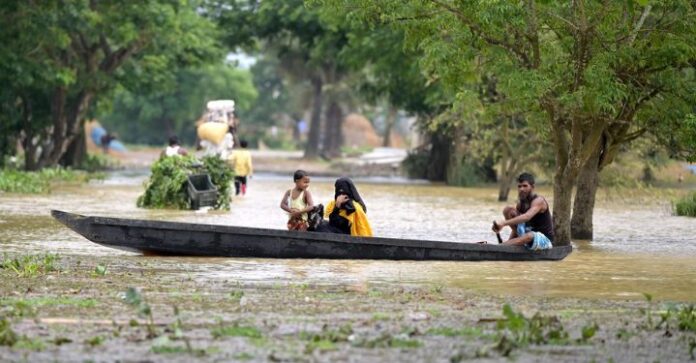Assam is grappling with one of its worst flood situations in recent years, with torrential rain continuing to wreak havoc across the state and the broader Northeast. The region is in crisis as the death toll rises to at least 36, including eight additional casualties reported within the last 24 hours. Over 5 lakh people in Assam alone are currently affected, and more than 700 landslides have been reported in adjoining northeastern states, disrupting life, infrastructure, and communication.
Escalating Impact
Floodwaters, driven by days of relentless monsoon rainfall, have submerged hundreds of villages and towns. The Brahmaputra and Barak rivers are flowing above danger levels in several districts. In Assam, 175 villages have been submerged across 12 districts, with Karimganj, Cachar, and Dima Hasao being among the worst affected.
More than 63,000 hectares of crop land have been devastated. Thousands of farmers are now facing the grim reality of lost harvests and food insecurity. Infrastructure has also taken a major hit—with washed-out roads, collapsed bridges, and broken electricity lines paralyzing movement and emergency response efforts.
Landslides, triggered by saturated soil in hilly areas, have compounded the tragedy. In Arunachal Pradesh, Manipur, Mizoram, and Nagaland, over 700 landslides have cut off entire villages, delayed rescue missions, and trapped hundreds in isolated regions.
Loss of Life and Livelihood
Among the most heart-wrenching incidents was a deadly landslide in Karimganj, Assam, where five members of a single family were buried alive. Elsewhere in the state, flood-related accidents, electrocutions, and building collapses have caused additional fatalities.
Wildlife sanctuaries have not been spared either. In Kaziranga National Park, famed for its one-horned rhinoceroses, at least 77 animals have perished, many while trying to escape rising waters. Park authorities, with support from the forest department and volunteers, are working round-the-clock to rescue stranded animals and relocate them to higher ground.
Massive Displacement and Humanitarian Needs
Over 2.5 million people have been affected across 30 districts of Assam. The Assam State Disaster Management Authority (ASDMA) reports that more than 290,000 people are taking refuge in nearly 500 relief camps. Many more are stranded or sheltered with relatives in less-affected areas.
Basic services like clean drinking water, food supplies, and medical assistance are in high demand. Relief agencies and local NGOs are working in coordination with government bodies to deliver aid, but the sheer scale of the disaster is stretching resources thin.
Government and Military Response
Prime Minister Narendra Modi held a high-level review meeting and expressed concern over the worsening situation. He assured the chief ministers of the affected states that the central government would provide all possible assistance. National Disaster Response Force (NDRF) teams, along with Army and Air Force personnel, have been deployed to support rescue operations.
The Ministry of Home Affairs is coordinating the release of emergency funds to state governments for flood relief. Temporary medical camps are being established, and mobile units are delivering first-aid and emergency healthcare services to remote locations.
Uncertain Future Amid Climate Concerns
Experts are warning that this crisis reflects a larger pattern of climate-related vulnerabilities in the Northeast. Irregular monsoon patterns, deforestation, unregulated construction in hilly terrains, and poor drainage infrastructure are exacerbating the impact of heavy rainfall.
The India Meteorological Department (IMD) has forecast continued rainfall in the region, prompting red alerts in several districts. Evacuations have been ordered in vulnerable areas, and schools have been shut down in high-risk zones.

